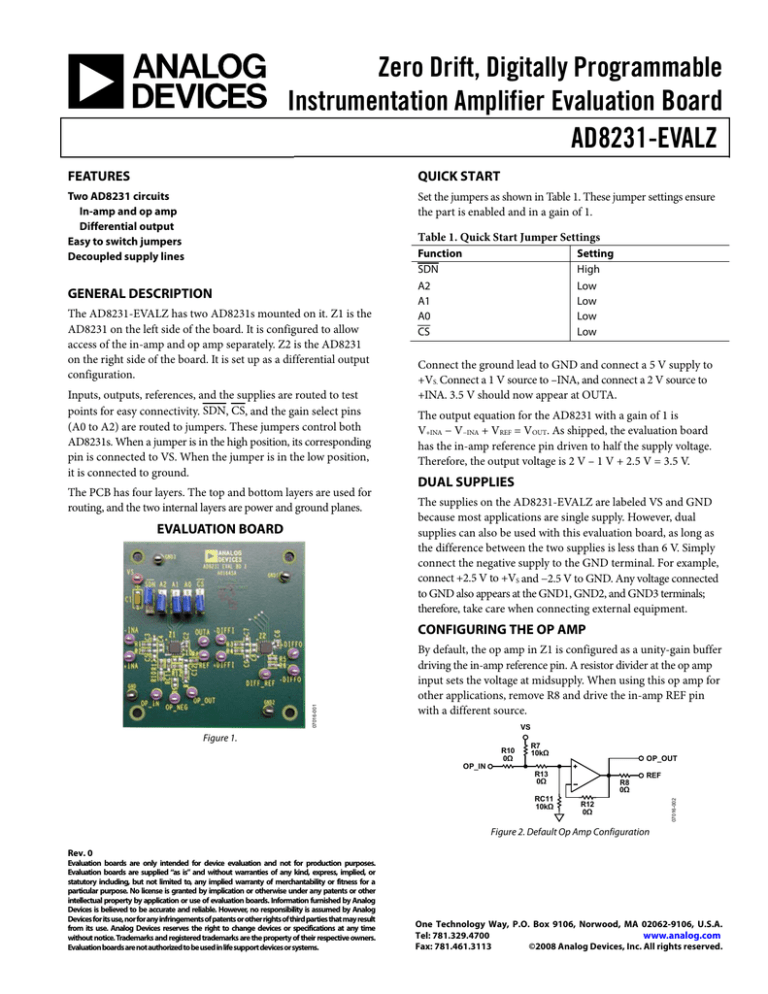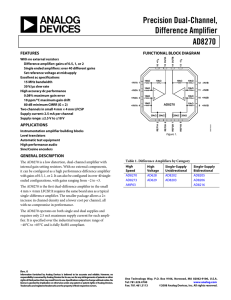Zero Drift, Digitally Programmable Instrumentation Amplifier Evaluation Board AD8231-EVALZ
advertisement

Zero Drift, Digitally Programmable Instrumentation Amplifier Evaluation Board AD8231-EVALZ FEATURES QUICK START Two AD8231 circuits In-amp and op amp Differential output Easy to switch jumpers Decoupled supply lines Set the jumpers as shown in Table 1. These jumper settings ensure the part is enabled and in a gain of 1. Table 1. Quick Start Jumper Settings GENERAL DESCRIPTION The AD8231-EVALZ has two AD8231s mounted on it. Z1 is the AD8231 on the left side of the board. It is configured to allow access of the in-amp and op amp separately. Z2 is the AD8231 on the right side of the board. It is set up as a differential output configuration. Inputs, outputs, references, and the supplies are routed to test points for easy connectivity. SDN, CS, and the gain select pins (A0 to A2) are routed to jumpers. These jumpers control both AD8231s. When a jumper is in the high position, its corresponding pin is connected to VS. When the jumper is in the low position, it is connected to ground. The PCB has four layers. The top and bottom layers are used for routing, and the two internal layers are power and ground planes. EVALUATION BOARD Function SDN A2 A1 A0 CS Setting High Low Low Low Low Connect the ground lead to GND and connect a 5 V supply to +VS. Connect a 1 V source to –INA, and connect a 2 V source to +INA. 3.5 V should now appear at OUTA. The output equation for the AD8231 with a gain of 1 is V+INA − V−INA + VREF = VOUT. As shipped, the evaluation board has the in-amp reference pin driven to half the supply voltage. Therefore, the output voltage is 2 V – 1 V + 2.5 V = 3.5 V. DUAL SUPPLIES The supplies on the AD8231-EVALZ are labeled VS and GND because most applications are single supply. However, dual supplies can also be used with this evaluation board, as long as the difference between the two supplies is less than 6 V. Simply connect the negative supply to the GND terminal. For example, connect +2.5 V to +VS and −2.5 V to GND. Any voltage connected to GND also appears at the GND1, GND2, and GND3 terminals; therefore, take care when connecting external equipment. By default, the op amp in Z1 is configured as a unity-gain buffer driving the in-amp reference pin. A resistor divider at the op amp input sets the voltage at midsupply. When using this op amp for other applications, remove R8 and drive the in-amp REF pin with a different source. VS Figure 1. OP_IN R10 0Ω R7 10kΩ OP_OUT R13 0Ω RC11 10kΩ R8 0Ω REF R12 0Ω 07016-002 07016-001 CONFIGURING THE OP AMP Figure 2. Default Op Amp Configuration Rev. 0 Evaluation boards are only intended for device evaluation and not for production purposes. Evaluation boards are supplied “as is” and without warranties of any kind, express, implied, or statutory including, but not limited to, any implied warranty of merchantability or fitness for a particular purpose. No license is granted by implication or otherwise under any patents or other intellectual property by application or use of evaluation boards. Information furnished by Analog Devices is believed to be accurate and reliable. However, no responsibility is assumed by Analog Devices for its use, nor for any infringements of patents or other rights of third parties that may result from its use. Analog Devices reserves the right to change devices or specifications at any time without notice. Trademarks and registered trademarks are the property of their respective owners. Evaluation boards are not authorized to be used in life support devices or systems. One Technology Way, P.O. Box 9106, Norwood, MA 02062-9106, U.S.A. www.analog.com Tel: 781.329.4700 Fax: 781.461.3113 ©2008 Analog Devices, Inc. All rights reserved. AD8231-EVALZ VS CS C1 + 10µF A0 A1 13 14 15 16 13 14 16 15 A2 SDN VS 6 C9 SPARE IN-AMP 3 R5 10kΩ 4 R8 0Ω C12 SPARE R12 0Ω VS R9 SPARE OP_NEG OP_IN R10 0Ω OP AMP AD8231 C10 SPARE R7 R13 10kΩ 0Ω 10 9 R6 10kΩ +DIFFO –DIFFO 07016-005 5 RC11 10kΩ R4 0Ω REF OP AMP AD8231 C8 SPARE 8 9 +DIFFI C6 0.1µF 11 7 4 OUTA R3 0Ω LOGIC 2 6 10 C7 SPARE DIFF_REF C5 SPARE IN-AMP 3 –DIFFI 5 R2 0Ω C4 SPARE C2 0.1µF 11 OP_OUT R1 0Ω LOGIC 2 12 1 8 +INA C3 SPARE 7 –INA VS 12 1 Figure 3. AD8231-EVALZ Schematic Additional 0603 component pads have been placed and routed to allow several other types of op amp configurations. Figure 4 shows how to put the op amp in either an inverting or noninverting gain configuration. To make a noninverting configuration, drive the OP_IN pin with the incoming signal and the OP_NEG pin with a bias voltage. For an inverting configuration, drive the OP_NEG pin with the incoming signal and the OP_IN pin with a bias voltage. The op amp can also be configured for filtering. Figure 5 shows how to make a Sallen-Key filter. C12 OP_IN R10 R13 OP_OUT RC11 R12 OP_OUT OP_NEG R12 Figure 5. Sallen-Key Filter OP_NEG 07016-003 R9 Figure 4. Inverting or Noninverting Configuration ORDERING GUIDE Model AD8231-EVALZ1 1 Z = RoHS Compliant Part. ESD CAUTION ©2008 Analog Devices, Inc. All rights reserved. Trademarks and registered trademarks are the property of their respective owners. EB07016-0-11/08(0) Rev. 0 | Page 2 of 2 Description Evaluation Board 07016-004 R9 OP_IN






